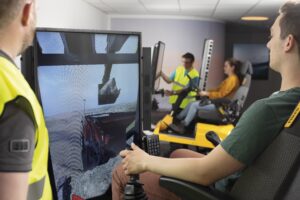
Almost like the real thing
By Jacob Stoller
Construction Equipment Technology Skills Development SoftwareHeavy equipment training simulators provide a more realistic training experience than they did a decade ago. They are not, however, a substitute for live training.
Heavy equipment simulators look a lot like video games. That said, the cautious behaviour that simulators are designed to instil couldn’t differ more from the aggressive risk-taking that earns high game scores.
Heavy equipment operation requires a precise set of skills that were traditionally developed over thousands of hours in live environments. Seasoned operators claim that it’s the physical feedback – the sounds, smells, impacts and vibrations – that guides them in their everyday work. Accordingly, it’s understandable that many are skeptical about the value of simulator training.
“We’ve had simulators in our program for 13 or 14 years,” says Lawrence Boyd of Nova Scotia Community College (NSCC). “Our faculty is old school, and at first they weren’t sure of the value of simulators. But they’ve proven to be a great way to get the students introduced to the mechanics of how the equipment operates.”
Schools like NSCC use simulators to shorten and augment the training cycle as part of a blended learning approach. Students can learn, for example, how to read the instrumentation panel and get the feel of the controls before taking the seat on a live machine.
“They’re as close to getting out into the real thing as you can get,” says Andrew Coles at Vancouver Island University. “We get the students onto simulators because it really helps with their muscle memory. They’re learning the controls before they actually move the machine around.”
The exercises are much more than driving lessons, however. Simulators can be programmed to present and reinforce a variety of training objectives such as safe operating procedures.
Coles explains that all the same steps are followed in simulator exercises. “This forces them to follow safe operating procedures so that when they get onto the machine, they know those procedures.”
Simulators can also present a student with a wide variety of terrain environments and operating techniques. “You can go from trenching to top loading, bank loading or flat-ground truck loading, whether it’s an excavator or a wheel loader,” says Wade Turlington, at Volvo Construction Equipment.
The simulator experience also reduces the anxiety of the initial experience with a live machine. “Years ago, first getting into that piece of equipment and starting up the engine was a daunting experience,” says Boyd. “Simulation has eliminated that start-up hesitancy.”
Moving seats that provide motion feedback help to reduce that anxiety. In a study conducted by University of North Carolina and Volvo CE, participants operating a live machine for the first time who had previously trained on motion feedback simulators had lower heart rates compared with participants trained on non-motion machines or on no simulator at all.
“The group that had the lower heart rate and was most productive was the one that did the exercise on the simulator with full motion,” says Turlington, adding that simulators can also train operators to avoid costly mistakes. “When an operator drives into a pile, you want to teach the operator not to go in with the machine articulated one way or the other.”
Similarly, the machines can train operators to economize on movement, power, and fuel consumption. “All these things help the operator be more productive, more efficient, and burn less fuel,” he says.
Looking ahead
Three-dimensional virtual reality platforms, offered by start-ups such as Edmonton-based Serious Labs, could well define the next generation of heavy equipment simulators. “I think people will be able to use their gaming setups at home to do virtual training,” says Turlington.
As remote control sees wider adoption in construction, a day may come when a simulator-like environment becomes the predominant method for controlling live machinery. In that scenario, operating a simulator won’t just resemble the real thing – it will be the real thing. And younger operators are likely to adapt to that without too much trouble.
“With the new generation of students, it’s not that big a stretch to be operating equipment from behind a computer,” says Boyd.
Jacob Stoller is principal of StollerStrategies. Send comments to editor@on-sitemag.com.






